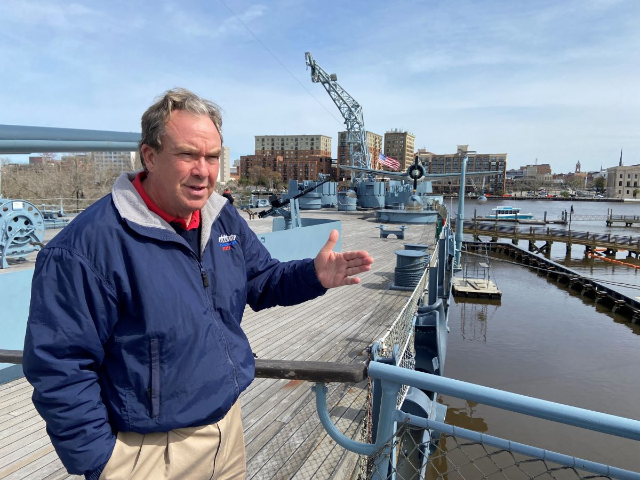 | Know better. Do better. |  | Climate. Change.News from the ground, in a warming world |
|
| | | By Jack Graham | Climate change and nature correspondent, UK | | |
|  |
| Living with water
In the city of Wilmington, on the U.S. East Coast, there floats a famous World War II battleship called the USS North Carolina.
The major tourist attraction is having some trouble with its parking lot, which is frequently flooded because of high tides. It recently launched a project called "Living with Water", aiming to turn part of the lot into a wetland habitat.
As if by design, the parking lot flooded again on the day of the kick-off ceremony.
Because in Wilmington, more and more people are themselves deciding to live with water. The city's population is booming and real estate developers are eyeing beachfront deals, just as risks from sea level rise and flooding surge.
 Terry Bragg, executive director of the Battleship North Carolina, is pictured on the ship across the Cape Fear River from downtown Wilmington in North Carolina, USA, February 29, 2024. Thomson Reuters Foundation/David Sherfinski |
This week, my colleague David Sherfinski reports on the community's growing battle over building in the flood-prone area of New Hanover County.
Activists he spoke with are trying to stop developers from building more major developments in a region which has faced a barrage of recent storms. It is at major risk of flooding again over the next 30 years, according to First Street Foundation, a climate risk tracking group.
"Risky isn't even the right word," said Kemp Burdette with Cape Fear River Watch, an advocacy group. "Risk indicates that something might happen or it might not happen. A flood over there is inevitable."
But new residents are not being put off. The county's population grew by 11%, to about 225,000, between 2010 and 2020, compared to 7.4% growth for the country as a whole.
And developers say there are ways to build safely in the area, such as by using features to make buildings more flood resistant - even a "sacrificial first floor" and features to allow water to move more freely in the event of a flood.
"The argument that we shouldn't build in a floodplain ... well, most of our county is in a floodplain," said Kirk Pugh of KFJ Development Group.
|
Pick your poison
Wilmington is not alone.
As the population booms, people across the U.S. are moving to areas most at risk of adverse climate effects like flooding, wildfires, and extreme heat, according to a 2023 study from the real estate company Redfin.
Despite these threats, they are being lured by lower costs of living and amenities like proximity to water. A cheaper life by the sea sounds reasonable. But at what cost? Some states are even exploring restrictions on where and how to build in areas with climate risks.
 A woman checks on flood damage in Conway, South Carolina, USA almost two weeks after Hurricane Florence hit, on Sept. 26, 2018. Thomson Reuters Foundation/Julie Dermansky |
Daryl Fairweather, Redfin's chief economist, herself moved from Seattle, Washington, to Wisconsin in the Midwest in 2020.
She said it was partly to escape worsening wildfire smoke. But she then ran into the poor air quality that permeated much of the country from Canada's record wildfires last year.
"There's no place in the country that doesn't have climate risk," Fairweather said.
"I think people are just going to have to pick their poison (on) what climate risk they are willing to tolerate."
See you next week,
Jack
|
|
|
|